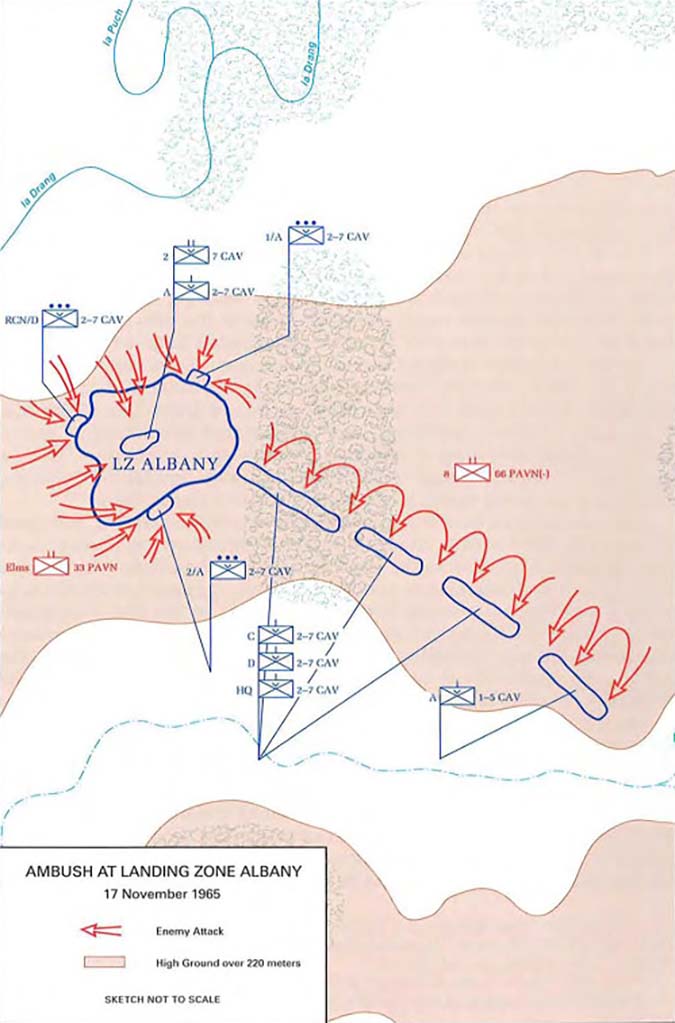Week of November 19
During the 1965 Pleiku Campaign in the Cao nguyên Trung phần (Central Highlands) of South Vietnam, the men of the U.S. Army 1st Cavalry Division dropped into the Ia Drang Valley on November 14, 1965. At the first landing zone, LZ X-Ray, they engaged a numerically superior force of North Vietnamese Army soldiers, which virtually surrounded the cavalrymen.
In the early morning of November 15, 1965—50 years ago this week—the firefight at X-Ray began again with renewed intensity. Within 30 minutes, at least 1,000 enemy soldiers attacked three sides of X-Ray in an all-out attempt to overrun the American position. The fight continued for another day and a night, but the American troopers continued to hold their ground. By late morning on November 16 the surviving North Vietnamese finally withdrew. The fight at X-Ray was the largest battle the United States had fought in Vietnam to that date. Over the course of two and a half days, 79 Americans had been killed and 121 had been wounded. As many as 1,000 North Vietnamese soldiers had been killed. But the combat in the Ia Drang Valley was far from finished.
On November 17, elements of the 5th and 7th Cavalry Regiments, which had mostly arrived as reinforcements earlier in the battle, left X-Ray on foot to occupy additional nearby landing zones. The men of the 7th headed toward one called Landing Zone Albany, several kilometers away. As they approached Albany, commanders halted the column in order to coordinate troop placement. They did not know that several North Vietnamese battalions had moved into positions just northeast of Albany. These enemy forces set up an ambush on the American column, and when they opened up in the early afternoon with mortar, machine gun, and rifle fire, the spread-out column of Americans “dissolved into confusion,” in the words of one U.S. captain. The firefight was intense and devastating. Making matters worse, U.S. units were disorganized, and tall grass and snipers concealed in the tree line made organizing a defense difficult.
The battle at Albany raged through the rest of the day and into the night of November 17–18. While many men managed to establish small perimeters, others who were caught or wounded in the open were later executed by roaming North Vietnamese soldiers. Air support proved vital once again, as pilots in A-1 Skyraiders strafed and dropped napalm canisters on North Vietnamese positions, sometimes hitting enemy troops mere yards from the U.S. cavalrymen. The fighting declined greatly at nightfall. Sometime in the night, most of the North Vietnamese Army units withdrew from the area, most likely into Cambodia to regroup. The Americans’ task for much of the next few days became looking for the wounded and recovering the dead. By November 19, most of the fighting of the Pleiku campaign was over.
The battle at Landing Zone Albany took another terrible toll on U.S. troops. Of the 400 men that had been ambushed there, 151 had been killed, 121 wounded, and 5 were still missing—a nearly 70 percent casualty rate. The battles in the Ia Drang Valley in the fall of 1965—especially at Landing Zones X-Ray and Albany—changed the war in Vietnam. Both U.S. and Communist troops gained important insights into each other’s tactics and capabilities, which would change how they would fight in the months and years ahead. The United States, having spent so much blood in the Cao nguyên Trung phần (Central Highlands), was drawn ever deeper into the conflict. Airmobile warfare concepts, most of which had proved their value in the campaign, continued to be crucial factors in American success on the battlefields of Southeast Asia.1
1Harold G. Moore and Joseph L. Galloway, We Were Soldiers Once . . . and Young: Ia Drang---the Battle that Changed the War in Vietnam (New York: Random House Publishing Group, 1992); John M. Carland, United States Army in Vietnam: Combat Operations: Stemming the Tide, May 1965 to October 1966 (Washington D.C.: Center of Military History, 2000), 113, 115–17, 120–22, 133, 136–40, 145–50; Stanley Karnow, Vietnam: A History (3rd revised edition; New York: Penguin Books, 1997), 493–94; Spencer C. Tucker, ed., The Encyclopedia of the Vietnam War: A Political, Social, and Military History (2nd edition; Santa Barbara, CA: ABC-CLIO, 2011), 527–29.
 |
Sketched map depicting the ambush at Landing Zone X-Ray, November 17, 1965. (U.S. Army)